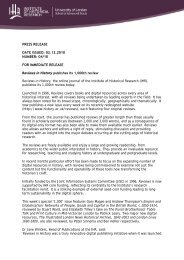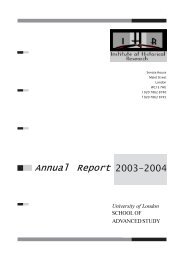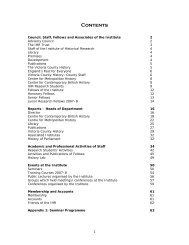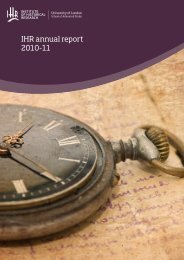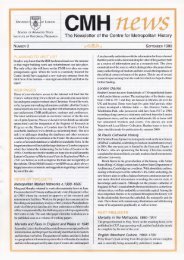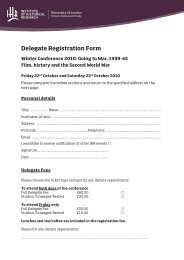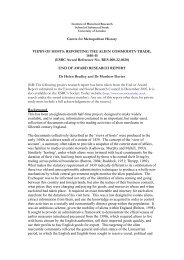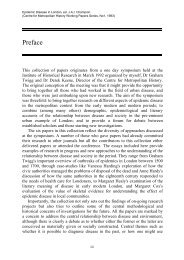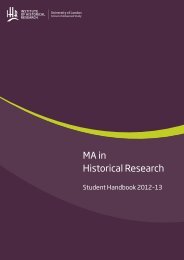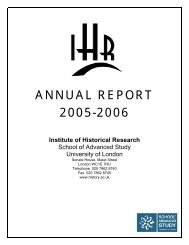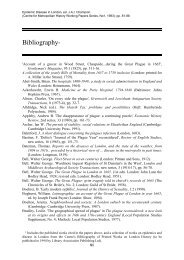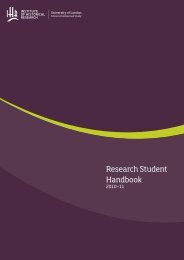CMH AnnuAl RepoRt 1999â2000 - Institute of Historical Research
CMH AnnuAl RepoRt 1999â2000 - Institute of Historical Research
CMH AnnuAl RepoRt 1999â2000 - Institute of Historical Research
Create successful ePaper yourself
Turn your PDF publications into a flip-book with our unique Google optimized e-Paper software.
UNIVERSITY OF LONDON<br />
SCHOOL OF ADVANCED STUDY<br />
INSTITUTE OF HISTORICAL RESEARCH<br />
C E N T R E<br />
F O R<br />
M E T R O P O L I T A N<br />
H I S T O R Y<br />
Annual Report 1999–2000<br />
(1 December 1999–30 November 2000)<br />
Page<br />
1. Director’s Report 2<br />
2. Project Reports<br />
i Metropolitan Market Networks c.1300–1600 5<br />
ii Markets and Fairs in England and Wales to AD 1516<br />
0<br />
iii Markets and Fairs in Thirteenth-Century England<br />
4<br />
iv St. Paul’s Cathedral History, 604–2004<br />
6<br />
v Bibliographical and Information Services:<br />
a) Checklist <strong>of</strong> Unpublished Diaries about London 24<br />
b) <strong>Research</strong> in Progress on the History <strong>of</strong> London 28<br />
c) Supplement to the Bibliography <strong>of</strong> Printed Works on London<br />
History to 1939 28<br />
d) Other Duties 28<br />
Appendices: I Patrons 29<br />
II Advisory Committee 30<br />
III Staff <strong>of</strong> the Centre 31<br />
IV Visiting <strong>Research</strong> Fellows 32<br />
V Postgraduate Student 32<br />
VI Conference and Seminar Papers 32<br />
VII Publications 33<br />
VIII Seminar on Metropolitan History 35<br />
IX Sources <strong>of</strong> Funding 36
<strong>CMH</strong> Annual Report 1999–2000<br />
1. DIRECTOR’S REPORT<br />
During the year the Centre has been active in three main research areas<br />
concerning London and its wider setting between the Middle Ages and the<br />
present. A new research project has been established and several potential themes<br />
for future research and related activities have been explored. A seminar series<br />
and conferences were organised. Seven staff were employed at the Centre in<br />
the course <strong>of</strong> the year, and former staff worked there from time to time. Three<br />
project advisers made greatly valued contributions to the work <strong>of</strong> the Centre,<br />
as did three Visiting Fellows <strong>of</strong> the <strong>Institute</strong> <strong>of</strong> <strong>Historical</strong> <strong>Research</strong> and one<br />
graduate student. Two other graduate students intermitted for the year.<br />
A major area <strong>of</strong> investigation during the year concerned the market network<br />
<strong>of</strong> medieval and early modern England and Wales, and London’s increasingly<br />
dominant role within it. Jim Galloway and Margaret Murphy continued their<br />
investigation <strong>of</strong> the latter issue by examining a large sample <strong>of</strong> debts arising in<br />
London and across the country between the early fourteenth and the late sixteenth<br />
century, together with evidence for variations in prices. The ESRC-funded<br />
element <strong>of</strong> this research ended in the summer <strong>of</strong> 2000, but it was possible to<br />
continue to the end <strong>of</strong> the year with an important stage <strong>of</strong> the project contributing<br />
towards the completion <strong>of</strong> a book on ‘London and the transformation <strong>of</strong> the<br />
English economy’. Data-gathering and initial examination <strong>of</strong> the material had<br />
produced many insights, but this stage saw the completion <strong>of</strong> the systematic<br />
analysis which allows a sound assessment <strong>of</strong> London’s increasing dominant role<br />
as an economic force (and so <strong>of</strong> its role as a cultural and political force too),<br />
as well as <strong>of</strong> those English regions which maintained and even enhanced their<br />
independence <strong>of</strong> the metropolis and <strong>of</strong> the forces overseas which did much to<br />
shape these changes.<br />
Samantha Letters completed her collection <strong>of</strong> material for a gazetteer <strong>of</strong> markets<br />
and fairs in England and Wales up to the early sixteenth century. With the end<br />
<strong>of</strong> ESRC funding for the project, further resources have been found which will<br />
help complete the editing and checking <strong>of</strong> the material. The gazetteer is being<br />
made available electronically on the Centre’s website and when complete will<br />
be published in paper form by the List and Index Society. By December 2000<br />
the entries for nine English counties had been made available on the website<br />
and it is anticipated that most <strong>of</strong> the remainder will be available by midsummer<br />
2001. The gazetteer is an immensely valuable resource for many types <strong>of</strong><br />
historical enquiry and has already attracted a great deal <strong>of</strong> interest. Moreover,<br />
it serves as the foundation for a new project funded by the ESRC, ‘Markets and
Director’s Report<br />
fairs in thirteenth-century England’, in which from November 2000 Samantha<br />
investigates the political economy <strong>of</strong> markets and fairs. The gazetteer reveals<br />
that while there was clearly an immense demand for new trading institutions,<br />
the incidence <strong>of</strong> grants <strong>of</strong> market privileges and the management <strong>of</strong> markets by<br />
their owners was heavily influenced by political factors, including patronage,<br />
warfare and the local interests <strong>of</strong> landowners.<br />
The new history <strong>of</strong> St Paul’s Cathedral, sponsored by the Dean and Chapter,<br />
makes steady progress. Several authors have already contributed drafts <strong>of</strong> their<br />
chapters, well in advance <strong>of</strong> the timetable. During the year Chris Faunch made<br />
an important contribution as research assistant to the history by investigating<br />
some <strong>of</strong> the less accessible sources and the immense collections <strong>of</strong> illustrative<br />
material, as she reports below.<br />
Perry Gauci’s book arising from his research at the Centre into ‘English merchant<br />
culture, 1660-1720’ will be published by the Oxford University Press in March<br />
2001. A significant event <strong>of</strong> the year will be the publication, in December 2000,<br />
<strong>of</strong> Craig Spence’s London in the 1690s: A Social Atlas, which presents an<br />
overview <strong>of</strong> the findings from one <strong>of</strong> the early large projects at the Centre and<br />
serves as an introduction to the substantial database drawn from tax records <strong>of</strong><br />
the period. The database is available for consultation at the Centre.<br />
Several <strong>of</strong> the Centre’s applications for funding for future projects were<br />
unsuccessful. However, we continue to pursue our objective, in association<br />
with colleagues in institutions outside London, <strong>of</strong> promoting long-range<br />
interdisciplinary investigation <strong>of</strong> the interaction between regional, metropolitan<br />
and national identities up to the present. Another important area for development<br />
will be to make new sources for London history and related themes more widely<br />
available, along with data arising from former research at the Centre. Experience<br />
with the gazetteer <strong>of</strong> markets and fairs points to ways <strong>of</strong> doing this. There have<br />
been other developments too, on which it will be possible to report next year.<br />
Following the intensive cluster <strong>of</strong> conferences and workshops organised in the<br />
summer <strong>of</strong> 1999, the Centre adopted a more extended programme for this year.<br />
We collaborated with the CORN (Comparative Rural History <strong>of</strong> the North Sea<br />
Area) group in organising a conference on food production and trading relations<br />
between town and country, held in Ghent in December 1999. In collaboration<br />
with the Corporation <strong>of</strong> London and the Museum <strong>of</strong> London we organised a<br />
conference in April 2000 — on the eve <strong>of</strong> the election <strong>of</strong> the new mayor <strong>of</strong><br />
London — on the governance <strong>of</strong> London over the last thousand years. The
<strong>CMH</strong> Annual Report 1999–2000<br />
papers will be published in The London Journal in the summer <strong>of</strong> 2001, and in<br />
the meantime versions <strong>of</strong> the papers can be read on the Corporation’s website,<br />
to which there is a link from the Centre’s home page. In the same month we<br />
helped Ian Gadd and Patrick Wallis to organise a conference on ‘Revisiting the<br />
Livery Companies <strong>of</strong> Early Modern London’, the proceedings <strong>of</strong> which will be<br />
published in 2001. In September, in association with Moscow colleagues, we<br />
ran a session on metropolitan history at the International Congress on Urban<br />
History in Berlin. In October we organised an Anglo-Italian workshop, at which<br />
a group <strong>of</strong> historians from the University <strong>of</strong> Bologna presented their innovative,<br />
multi-media approach to reconstructing and investigating the medieval city,<br />
while on the English side historians explained and compared the approaches<br />
that had been adopted here and an analyst <strong>of</strong> urban form discussed London as<br />
a fractal entity. The regular seminar on Metropolitan History included a wide<br />
range <strong>of</strong> papers on aspects <strong>of</strong> marginality and the city.<br />
As part <strong>of</strong> his writing programme, the Director finally managed to complete<br />
his extended, and challenging, task <strong>of</strong> surveying commerce and urbanisation<br />
throughout the whole <strong>of</strong> Europe, A.D. 1000–1200, as a contribution to the<br />
Cambridge Medieval History. He also lectured and published on many other<br />
themes, and served as a member <strong>of</strong> English Heritage’s Urban Panel and its<br />
London Advisory Committee, <strong>of</strong> the International Commission for the History<br />
<strong>of</strong> Towns, <strong>of</strong> the Fabric Advisory Committee <strong>of</strong> St Paul’s Cathedral, <strong>of</strong> the<br />
British Historic Towns Atlas Committee and as managing trustee <strong>of</strong> the London<br />
Journal.<br />
The Centre welcomed many visitors during the year, including overseas visitors<br />
from Australia, Belgium, France, Germany, Italy, Spain, Sweden, and the United<br />
States.
Metropolitan Market Networks<br />
2. PROJECT REPORTS<br />
i<br />
METROPOLITAN MARKET NETWORKS c.1300–1600<br />
This project has sought to answer questions concerning the development <strong>of</strong><br />
efficient markets and the role <strong>of</strong> dominant cities in that process. Focusing on<br />
England between 1300 and 1600 and on the impact <strong>of</strong> London on its hinterland<br />
and more distant regions, the research has built upon the approaches used in<br />
previous studies based at the Centre (further information on ‘Feeding the City I<br />
and II’ and ‘Market networks in the London Region c.1400’ is available on the<br />
<strong>CMH</strong> website under ‘<strong>Research</strong> projects’). The final year <strong>of</strong> this particular threeyear<br />
project, funded by the Economic and Social <strong>Research</strong> Council (Award No.<br />
R000237253), came to an end on 31 July 2000. The full results <strong>of</strong> the research will<br />
be presented in a book, with the provisional title London and the Transformation <strong>of</strong><br />
the English Economy: Market Networks in Transition, 1300–1600, being written<br />
for publication by the Cambridge University Press in 2002.<br />
The project had two principal components. One used the records <strong>of</strong> a sample<br />
<strong>of</strong> debt cases in the central Court <strong>of</strong> Common Pleas in cross-sectional analyses<br />
<strong>of</strong> commercial networks at three successive dates within the period. The cases<br />
originated in London, the counties <strong>of</strong> its immediate hinterland (Bedfordshire,<br />
Berkshire, Buckinghamshire, Essex, Hertfordshire, Kent, Middlesex,<br />
Northamptonshire, Oxfordshire and Surrey) and the outlying counties <strong>of</strong> Devon,<br />
Staffordshire and Yorkshire. In addition to their coverage <strong>of</strong> these counties,<br />
the records provide an accurate picture <strong>of</strong> the activities <strong>of</strong> London creditors<br />
throughout the kingdom. The second component dealt with the evidence <strong>of</strong> grain<br />
(mainly wheat) prices, with the aim <strong>of</strong> estimating the degree <strong>of</strong> integration in<br />
the market for this important basic commodity.<br />
Common Plea records are complex and vary considerably over time, but an<br />
important outcome <strong>of</strong> the research has been to demonstrate that they provide a<br />
robust basis for analysing changes in commercial networks over the long run. In<br />
order to make the best use <strong>of</strong> relevant information (including the occupations and<br />
places <strong>of</strong> residence <strong>of</strong> parties) substantial datasets for analysis were compiled from<br />
the rolls for the Michaelmas terms <strong>of</strong> 1329, 1424 and 1570. This information (from<br />
over 8,000 cases) was analysed and mapped. The occurrence and occupational<br />
pr<strong>of</strong>iles <strong>of</strong> debtors and creditors residing in particular towns, counties and regions<br />
were tabulated and the value <strong>of</strong> their debts analysed. Urban hinterlands were<br />
mapped, using both point and county-based values. The material is especially good<br />
for reconstructing the extent and density <strong>of</strong> London’s contacts, but also provides
<strong>CMH</strong> Annual Report 1999–2000<br />
comparable pictures for other towns, including Exeter and York. In addition, debt<br />
information from City <strong>of</strong> London records around 1300 and from the records <strong>of</strong><br />
other towns at later dates was analysed in a similar fashion.<br />
The price series are fragmentary and ‘low-grade’ by comparison with modern<br />
data, and thus constrained the types <strong>of</strong> analysis which could be undertaken.<br />
Nevertheless, useful series within the period 1277–1640 were compiled for<br />
London, Exeter, Canterbury, Chester and a range <strong>of</strong> bishopric <strong>of</strong> Winchester<br />
manors in southern England. Comparisons were drawn with series for Antwerp,<br />
Bruges and Douai. Statistical analysis <strong>of</strong> co-variation <strong>of</strong> detrended series (the<br />
standard method <strong>of</strong> measuring the degree <strong>of</strong> integration) was possible only<br />
for parts <strong>of</strong> some <strong>of</strong> the series. Other revealing exercises have included visual<br />
comparison <strong>of</strong> graphed series for pairs <strong>of</strong> places, and measurement <strong>of</strong> temporal<br />
and spatial variations in price volatility.<br />
Some <strong>of</strong> the preliminary results <strong>of</strong> debt and price analysis appeared in James A.<br />
Galloway (ed), Trade, Urban Hinterlands, and Market Integration c.1300–1600<br />
— a volume in the <strong>CMH</strong> Working Papers Series published in May 2000 (copies<br />
available from the <strong>Institute</strong> <strong>of</strong> <strong>Historical</strong> <strong>Research</strong>’s bookshop, price £10)<br />
— along with contributions concerning related issues and other European regions<br />
from Richard Britnell, Franz Irsigler and Herbert Eiden, Pamela Nightingale<br />
and Christopher Dyer.<br />
Overall, the results point to a regionally-differentiated pattern <strong>of</strong> change over the<br />
three centuries rather than a straightforward linear trend towards an integrated<br />
system focusing on London, although the steady increase in the relative wealth<br />
and influence <strong>of</strong> the metropolis is revealed. Several distinctive types <strong>of</strong> interaction<br />
between London, its immediate hinterland, and more distant regions have been<br />
identified, along with episodes in which some markets became less, rather than<br />
more, integrated. International markets, especially those linked by the English<br />
Channel and the southern part <strong>of</strong> the North Sea, had an important influence on<br />
these changes. To a large extent they worked through London thus contributing to<br />
the way in which the capital undermined the commercial independence <strong>of</strong> some<br />
provincial towns, but they seem also to have had direct and positive effects on<br />
Exeter and the South West. At the same time, the fall in interest rates over the<br />
period as a whole indicates a general improvement in the conditions <strong>of</strong> trade.<br />
The results thus constitute a case study in the evolution <strong>of</strong> commercial systems,<br />
emphasising the role <strong>of</strong> cumulative, small-scale change and <strong>of</strong> reactions to a<br />
changing commercial environment, rather than the significance <strong>of</strong> dramatic<br />
transition from one ‘system’ <strong>of</strong> production or distribution to another.
Metropolitan Market Networks<br />
Despite London’s great size in the early fourteenth century, its hinterland, as<br />
defined by intensive commercial interaction, appears to have been limited to the<br />
south-east and the Midlands. By 1424 that hinterland took in much <strong>of</strong> England,<br />
at a date significantly earlier than sometimes suggested. Further change by 1570<br />
concerned the structure <strong>of</strong> that hinterland rather than its extent. The principal<br />
shifts evident between 1424 and 1570 include the increasing dependence <strong>of</strong> the<br />
territory immediately around London on the city itself, a decline in the relative<br />
intensity <strong>of</strong> contacts with counties to the south and east <strong>of</strong> London, a corresponding<br />
relative increase in contact with interior counties to the north and west, including<br />
Hertfordshire, Bedfordshire, Wiltshire and Warwickshire, and an increase in the<br />
proportion <strong>of</strong> debts contracted between inhabitants <strong>of</strong> the capital itself. There is<br />
also an increase evident in contacts between London and Yorkshire, Cheshire<br />
and Northumberland, although not apparently with other northern counties,<br />
while a relative decline in contacts with Devon and Cornwall is indicated (see<br />
Fig. 1). These changes, which on the whole contrast with the marked national<br />
shift in population and wealth in favour <strong>of</strong> the south-east between the fourteenth<br />
and sixteenth centuries, suggest that within that region there was a movement<br />
<strong>of</strong> business into London itself while, at least at some levels <strong>of</strong> commerce, more<br />
distant counties were becoming more important for Londoners than those in its<br />
immediate vicinity. In particular, London became a more dominant market for<br />
livestock and coal. In several regions Londoners had come to intervene directly<br />
in the market for local products, rather than operating through provincial centres<br />
and middlemen, as had been the case in 1424. In Exeter and Devon as a whole,<br />
however, the opposite took place. In the south-east, London seems to have become<br />
an increasingly dominant centre for retail trade.<br />
These changes, associated with trade in a wide range <strong>of</strong> commodities including<br />
manufactured goods and raw materials for industry, were not straightforwardly<br />
reflected in measures <strong>of</strong> wheat price integration. Comparison <strong>of</strong> Exeter and<br />
London prices and their relation to fluctuations in the Exeter grain trade<br />
suggest that in the early fourteenth century both places were part <strong>of</strong> a relatively<br />
well-integrated coastal wheat market in which London may not have been<br />
dominant. That market rather may have centred upon Flanders and other parts<br />
<strong>of</strong> the near-Continent as well as embracing coastal districts <strong>of</strong> south-eastern<br />
and south-western England. Decline in aggregate demand for cereals after the<br />
Black Death may have precipitated a decline in the level <strong>of</strong> integration <strong>of</strong> coastal<br />
grain markets. The 1360s seem to have ushered in a period <strong>of</strong> generally greater<br />
price volatility at Exeter, suggestive <strong>of</strong> a less efficient and less well integrated<br />
market. This trend to increasing volatility at Exeter culminated in the 1430s,<br />
after which a notable decline is evident until the last decade <strong>of</strong> the fifteenth
<strong>CMH</strong> Annual Report 1999–2000<br />
No. <strong>of</strong> debts<br />
10<br />
5<br />
1<br />
1329<br />
No. <strong>of</strong> debts<br />
10<br />
5<br />
1<br />
1424
Metropolitan Market Networks<br />
No. <strong>of</strong> debts<br />
10<br />
5<br />
1<br />
1570<br />
Fig 1. Debts owed to Londoners in 1329, 1424 and 1570<br />
From cases in the court <strong>of</strong> Common Pleas. The sample for 1329 is small, but enlarging it by taking<br />
account <strong>of</strong> pleas <strong>of</strong> account (which at that date indicate commercial contact in the same way as<br />
pleas <strong>of</strong> debt) does not significantly alter the picture. The expansion, by 1424, <strong>of</strong> London’s sphere<br />
<strong>of</strong> influence as a supplier <strong>of</strong> goods and credit is very striking. By 1570 it is apparent that London’s<br />
contact with coal-producing areas in the North East and with textile producing areas in Yorkshire<br />
and in Wiltshire and Somerset had sharply increased, while direct contact with the city <strong>of</strong> York and<br />
with Devon and Cornwall had diminished (for different reasons in each case).<br />
century, when volatility again increased. Both the rural and urban economies <strong>of</strong><br />
Devon performed well in the fifteenth century — real improvements in market<br />
organisation may have been associated with this prosperity.<br />
The apparently growing detachment <strong>of</strong> Exeter from a London-focused economy<br />
between 1424 and 1570 revealed by analysis <strong>of</strong> debt cautions against generalising<br />
from the Exeter data alone. Analysis <strong>of</strong> fifteenth-century prices from London<br />
(Westminster), Canterbury and Chester suggests that Exeter’s decline in volatility<br />
was shared by other southern markets, but that in the north-west the picture<br />
may have been very different. The movement <strong>of</strong> prices in later fifteenth-century<br />
Chester appears more violent and erratic than at any <strong>of</strong> the other locations,<br />
which may, in the absence <strong>of</strong> clear evidence for changing measures or other
<strong>CMH</strong> Annual Report 1999–2000<br />
ii MARKETS AND FAIRS IN ENGLAND AND WALES TO AD 1516<br />
The aim <strong>of</strong> this two-year project, which came to the end <strong>of</strong> its Economic and<br />
Social <strong>Research</strong> Council funding (Ref. No: R000237395) on 31 July, has been<br />
to produce a comprehensive survey <strong>of</strong> medieval markets and fairs.<br />
The network <strong>of</strong> markets and fairs in medieval England was one <strong>of</strong> the densest<br />
and most highly developed in Europe. The development <strong>of</strong> weekly or daily<br />
markets and annual fairs reflects trends in population, settlement, commerce<br />
and economic specialisation. It also sheds light on the exercise <strong>of</strong> power, both<br />
by local lords and by kings who claimed the right to regulate trade. Moreover, it<br />
relates to the evolution <strong>of</strong> laws concerning trade and to the complex relationship<br />
between the practice <strong>of</strong> commerce and the legal framework within which it<br />
operated. However, despite the importance <strong>of</strong> these trading institutions, until<br />
now no comprehensive national survey <strong>of</strong> them has been available, and such lists<br />
as have been prepared for individual counties vary in quality. No comparable<br />
lists are available for Wales.<br />
As detailed in previous <strong>CMH</strong> Annual Reports (1997–8, pp. 10–19; 1998–9, pp.<br />
10–15), the survey has been arranged as a gazetteer covering the period from<br />
the seventh to the sixteenth century. Every reference to a market (mercatum,<br />
forum) or fair (feria, nundinae) in the source material has been recorded. This<br />
includes both prescriptive markets and fairs (generally the oldest, which were<br />
held by established custom) and granted markets and fairs, which were usually<br />
held by virtue <strong>of</strong> a royal charter. The Gazetteer is arranged by county, and then<br />
by place in alphabetical order.<br />
The Gazetteer covers some 4,700 markets and fairs in England and Wales at<br />
over 2,100 places in England (more than 2,000 markets and nearly 2,500 fairs)<br />
and 139 places in Wales (103 markets and 137 fairs).<br />
Standard information is provided for each place, including: an eight figure grid<br />
reference; whether the place was a borough or had a mint (it is assumed that in<br />
the Anglo-Saxon and Anglo-Norman periods, such places operated as centres<br />
<strong>of</strong> trade and had a market); its assessed value in the 1334 lay subsidy; whether<br />
the market or fair survived in the sixteenth century (taken from Alan Everitt's<br />
list <strong>of</strong> markets c.1500 to 1640 in the Agrarian History <strong>of</strong> England and Wales,<br />
and from the list <strong>of</strong> fairs compiled in 1587 in W. Harrison, The Description <strong>of</strong><br />
England); and references to fuller accounts <strong>of</strong> its history, particularly those in<br />
the Victoria County History.<br />
10
Markets and Fairs in England and Wales to AD 1516<br />
Most <strong>of</strong> the markets and fairs covered are known because the right to hold<br />
them was granted by the king to individuals or to religious institutions. English<br />
kings had claimed this right to licence trading institutions by the late eleventh<br />
century, but do not appear to have successfully enforced this until the thirteenth<br />
century. From 1199 onwards, the grants were systematically recorded by the<br />
royal administration. From then until well into the fourteenth century there was<br />
a strong demand for grants <strong>of</strong> markets and fairs, reflecting economic growth<br />
and the desire <strong>of</strong> lords to manipulate and pr<strong>of</strong>it from trade in the districts where<br />
their estates lay. Subsequently, the number <strong>of</strong> grants fell sharply away and in<br />
addition, many <strong>of</strong> the markets and fairs which had been established earlier<br />
failed to survive. The Gazetteer identifies those markets and fairs which still<br />
existed about 1600. It contains as much information as possible regarding the<br />
establishment and operation <strong>of</strong> markets and fairs, within the confines <strong>of</strong> the<br />
sources used. The Gazetteer is derived mainly from extensive searches <strong>of</strong> printed<br />
primary sources concerning the royal administration (for example, Calendars <strong>of</strong><br />
Charter Rolls, Close Rolls and Letters Close); similar sources have been used<br />
to trace the operation <strong>of</strong> the markets and fairs after the initial grants.<br />
A substantial minority <strong>of</strong> markets and fairs were prescriptive. Held by established<br />
custom, they were <strong>of</strong>ten the most successful and long-lasting markets and fairs.<br />
Prescriptive markets were <strong>of</strong>ten sited in boroughs, or at places which had a mint<br />
in the Anglo-Saxon or Anglo-Norman period. The dates <strong>of</strong> boroughs and mints<br />
have been taken from standard secondary sources in order to provide a systematic<br />
overview <strong>of</strong> these early commercial sites. Often in such cases, the Gazetteer indicates<br />
that the first specific reference to a market dates from the thirteenth century, but that<br />
the place had been a borough or a mint for at least two centuries.<br />
The information was compiled as a database, using the Idealist free-text s<strong>of</strong>tware. The<br />
text <strong>of</strong> the Gazetteer can be generated automatically from this database. A selection<br />
<strong>of</strong> information from the database has also been transferred into a geographical<br />
information system. This truncated database is used for statistical and spatial analysis<br />
<strong>of</strong> markets and fairs according to region, date, and day <strong>of</strong> the week or season. It will<br />
be a powerful tool for investigating the evolution <strong>of</strong> commercial networks and local<br />
cycles <strong>of</strong> trade, as well as for establishing regional characteristics.<br />
Preliminary analysis confirms the hypotheses suggested in previous county<br />
studies that the number <strong>of</strong> markets and fairs granted in the thirteenth century<br />
rose steadily. The numbers granted declined after the mid fourteenth century<br />
and remained low throughout the fifteenth century. This is in contrast to the<br />
situation in continental Europe, where the greatest increase in the number <strong>of</strong><br />
11
<strong>CMH</strong> An n u a l Re p o rt 1999–2000<br />
markets and fairs occurred after the Black Death, when royal rights to control<br />
the establishment <strong>of</strong> trading institutions were successfully asserted. Evidence<br />
from the Gazetteer indicates that the overall increase in grants in England<br />
during the thirteenth century was puncuated by a number <strong>of</strong> years in which an<br />
exceptionally large number <strong>of</strong> charters were issued.<br />
The Gazetteer is a substantial document, which in hard copy will occupy some<br />
500 closely-printed pages. It is hoped that the List and Index Society will publish<br />
it in book form. However, in order for Gazetteer to be accessible to as large and<br />
diverse an audience as possible, it was decided that an on-line version should<br />
be made available on the Internet.<br />
The first part <strong>of</strong> the Gazetteer comprising nine counties (Derbyshire, Essex,<br />
Herefordshire, Middlesex, Rutland, Somerset, Sussex, Worcestershire and<br />
Yorkshire) went on-line at the end <strong>of</strong> November 2000 and can be accessed at<br />
. Additional funding from English<br />
Heritage and The Aurelius Trust will enable the remaining English counties and<br />
Fig 2. The Home Page <strong>of</strong> the On-Line Gazetteer <strong>of</strong> Markets and Fairs<br />
12
Ma r k e t s a n d Fa i r s in En g l a n d a n d Wa l e s to AD 1516<br />
Fig. 3. Example <strong>of</strong> a Gazetteer entry<br />
Wales to be added in 2001. An introduction, examples <strong>of</strong> how to read Gazetteer<br />
entries, a list <strong>of</strong> abbreviations and a glossary <strong>of</strong> terms used in the Gazetteer are also<br />
provided on-line, together with an index to places. Indexes to people and institutions<br />
will be added shortly. A further advantage <strong>of</strong> the on-line version is that it can be<br />
readily updated as further information on markets and fairs comes to hand.<br />
It should be noted that the Gazetteer is not definitive and there is a great deal<br />
more information on medieval markets and fairs to be found in miscellaneous<br />
and unpublished sources. The Centre actively welcomes any corrections and<br />
new information from users.<br />
The Gazetteer will become a primary research tool for historians, historical<br />
geographers, archaeologists and economists. It will also be a major reference<br />
work <strong>of</strong> value beyond the academic community, for example to those interested<br />
in local studies. It aims to provide as much information as possible regarding<br />
the establishment and operation <strong>of</strong> markets and fairs during the medieval period.<br />
The appeal <strong>of</strong> the Gazetteer will extend beyond those interested in that period,<br />
as the markets and fairs established at this time formed the core <strong>of</strong> the network<br />
which survived into the sixteenth century and beyond. It is also being used as<br />
a basis for a new project exploring Markets and Fairs in Thirteenth-Century<br />
England (see pp. 14–15, below).<br />
13
<strong>CMH</strong> Annual Report 1999–2000<br />
iii<br />
MARKETS AND FAIRS IN THIRTEENTH-CENTURY ENGLAND<br />
This three year project, funded by the ESRC (no. R000239108) started on 1 November<br />
2000. The research <strong>of</strong>ficer is Dr Samantha Letters, supervised by Dr Derek Keene;<br />
the advisors are Pr<strong>of</strong>essor Richard Britnell and Dr David Carpenter.<br />
The early development <strong>of</strong> markets and fairs is an issue <strong>of</strong> central significance in<br />
economic history and historical geography. The network <strong>of</strong> legally established<br />
markets and fairs in medieval England, almost all <strong>of</strong> them authorised by royal<br />
grant, was dense, highly developed and apparently originated earlier than in<br />
much <strong>of</strong> Europe. The already complex marketing network <strong>of</strong> England was<br />
supplemented during the thirteenth century by a great increase in the number<br />
<strong>of</strong> grants <strong>of</strong> markets and fairs. This project will examine the reasons for this<br />
increase, taking account <strong>of</strong> political and institutional factors as well as the<br />
economic ones which have dominated discussion in the past. Why these rights<br />
were granted, whether the markets and fairs were successful and how they<br />
were managed as part <strong>of</strong> a portfolio <strong>of</strong> lordly resources are central topics. The<br />
project builds upon the Centre’s recently completed Gazetteer <strong>of</strong> Markets and<br />
Fairs in England and Wales to 1516 (see pp. 10–13 above), using the evidence<br />
to study the establishment and operation <strong>of</strong> markets and fairs on a national scale<br />
for the first time.<br />
The project will focus on two issues. Firstly, the spatial and temporal variation<br />
in the establishment <strong>of</strong> English markets and fairs, and the success <strong>of</strong> those<br />
institutions over the medieval period as a whole. This will comprise an overview,<br />
derived primarily from the Gazetteer, <strong>of</strong> the trends in the foundation <strong>of</strong> markets<br />
and fairs in England and Wales between c.900 and 1516 and in their survival to<br />
c.1600. The markets and fairs will be considered in the context <strong>of</strong> broad trends<br />
in economic activity, political control and the exercise <strong>of</strong> justice.<br />
The second part <strong>of</strong> the project is the control and exploitation <strong>of</strong> markets and fairs<br />
by their owners and by royal authority during the period 1199–1272. The first<br />
and most important theme will be assessing the grants <strong>of</strong> markets and fairs in<br />
their political and economic context. Four key periods will be studied in detail:<br />
John’s reign, the minority <strong>of</strong> Henry III, the 1250s and Edward II’s reign. Work<br />
has begun on test case, looking at grants during the regency <strong>of</strong> William Marshall<br />
in 1216–19. The fifty grants made either involved new markets or fairs, or made<br />
changes to existing trading institutions. An attempt has been made to set each <strong>of</strong><br />
these in its political context, by considering the loyalty <strong>of</strong> the recipient during<br />
the civil war and after, their position at court and relationship to the regent or to<br />
14
Markets and Fairs in Thirteenth-Century England<br />
the king. The grants have also been considered in their context ‘on the ground’,<br />
that is within the spatial and temporal network <strong>of</strong> existing markets and fairs. An<br />
additional factor to be considered is the impact <strong>of</strong> a movement against Sunday<br />
trading, promoted by the papacy, which was highly topical. Initial results indicate<br />
that many recipients <strong>of</strong> grants <strong>of</strong> markets and fairs were closely connected to<br />
the regent, suggesting that issues <strong>of</strong> patronage and the political context <strong>of</strong> grants<br />
will be a rewarding area for further research. The impact <strong>of</strong> the anti-Sunday<br />
trading movement also appears to have been significant. The effect <strong>of</strong> this on<br />
local market networks will be analysed over the next few months.<br />
The second theme <strong>of</strong> the project will be to consider markets and fairs from<br />
the point <strong>of</strong> view <strong>of</strong> the individuals who owned them. The most important<br />
individual will be the king: as a major landlord, he directly controlled many<br />
trading institutions on his estates. This study will be the first to investigate the<br />
administration <strong>of</strong> markets on the royal demesne on a national scale. Few <strong>of</strong> the<br />
county studies <strong>of</strong> markets so far published deal with royal markets and fairs.<br />
The investigation will assess the chronology and location <strong>of</strong> markets and fairs<br />
on the royal demesne, and will consider how they fitted into existing networks<br />
<strong>of</strong> trade. The reasons for the establishment <strong>of</strong> these markets and fairs will be<br />
examined, including the provisioning <strong>of</strong> the royal household, their potential as a<br />
means to raise income and as status symbols. It is likely that this will concentrate<br />
on the 1230s and 1240s. The other major landlord to be studied will be Peter<br />
des Roches, bishop <strong>of</strong> Winchester (1205–38).<br />
Another theme will be the legal, administrative and financial restrictions on<br />
marketing enforced by the king. Overall, these changes increased the need for<br />
access to the king, who thus acquired new opportunities for patronage. and thus<br />
made the issue <strong>of</strong> grants a potential object <strong>of</strong> royal patronage. Key questions in<br />
this part <strong>of</strong> the study concern the degree to which John and Henry III exploited<br />
those opportunities, and the way in which additions and adjustments to the<br />
network <strong>of</strong> trading institutions reflect contemporary perceptions and practice<br />
in its operation.<br />
The main focus <strong>of</strong> the project will be to produce a monograph. It is hoped that<br />
several papers will be given during the course <strong>of</strong> the project including one at<br />
the Thirteenth Century England conference at Durham in 2001. A page for the<br />
project has been set up on the <strong>CMH</strong> website and further news will be posted at<br />
.<br />
15
<strong>CMH</strong> Annual Report 1999–2000<br />
iv ST PAUL’S CATHEDRAL HISTORY, 604–2004<br />
Last year we introduced our new project to produce a comprehensive history <strong>of</strong><br />
St Paul’s Cathedral, sponsored by the Dean and Chapter and to be published in<br />
2004, when as an institution the cathedral will be 1,400 years old. Since then<br />
arrangements have been finalised with the authors <strong>of</strong> the chapters concerning<br />
music at the cathedral, making a total <strong>of</strong> forty-three authors in all. Work is<br />
progressing steadily with the chapters. Many new discoveries are being made and<br />
it is already clear that the project will promote further studies and publications<br />
after the history itself is completed. Drafts <strong>of</strong> most chapters are expected in<br />
Autumn 2001, but several have already been submitted.<br />
There have been several meetings for contributors, some <strong>of</strong> a predominantly<br />
social character and others (no less social) focusing on particular themes or<br />
periods.<br />
The project’s research <strong>of</strong>ficer, Chris Faunch, completed her first year in August<br />
2000, and her contract has been extended for twelve months in order that she<br />
can continue to identify source material. During the last year she has produced<br />
a number <strong>of</strong> reports on the archives which have led to some exciting discoveries<br />
and ‘re-discoveries’ for contributors. These range from specialist papers on the<br />
state <strong>of</strong> the cathedral fabric and decoration to an early seventeenth-century list<br />
<strong>of</strong> printed books which had not been seen for many years. At the time <strong>of</strong> the<br />
last Annual Report, Chris had just completed reports on the St Paul’s records<br />
at the Guildhall Library and in the Cathedral Library. Since then, she has<br />
investigated the Cathedral’s fabric archive and visited a considerable number <strong>of</strong><br />
other libraries, galleries and archive collections. She reported on the St Paul’s<br />
project and archives to the London Archive Users’ Forum.<br />
In addition to the work undertaken on archival holdings, research this year has<br />
included more detailed work on particular papers and topics, sometimes in response<br />
to the specific requirements <strong>of</strong> contributors. Searches have produced information<br />
for the history on collections <strong>of</strong> estate maps, clergy, portraits <strong>of</strong> people connected<br />
with the cathedral, and key individual documents, such as visitation depositions,<br />
contracts, diary material (like Canon Hall’s mentioned on p. 26) and drawings.<br />
The history will be well illustrated, with about 400 images. An important focus <strong>of</strong><br />
the research this year has concerned graphic material and we have begun to consult<br />
contributors over their requirements for illustrations. The aim is to co-ordinate the<br />
graphic content <strong>of</strong> the book and to use sequences <strong>of</strong> illustrations to express specific<br />
16
St Paul’s Cathedral History<br />
arguments and themes concerning the cathedral and its activities. In many instances<br />
pictures will tell the story more effectively than words. In addition, there will be<br />
a chapter specifically devoted to artistic representations <strong>of</strong> the cathedral.<br />
Subjects particularly rich in illustrative matter range from material issues such<br />
as the archaeology <strong>of</strong> the site, the architecture and engineering <strong>of</strong> the cathedral<br />
and precinct, monuments, decoration and estates, to the representation <strong>of</strong> public<br />
occasions, preaching and the social life <strong>of</strong> the environs. An overarching theme<br />
concerns the way in which the cathedral has been depicted as a place <strong>of</strong> worship<br />
and as a monument in its active and symbolic roles both in the city <strong>of</strong> London<br />
and in the wider national consciousness.<br />
The cathedral’s national role is particularly well represented over the last century,<br />
in moving as well as in static photographic images. The Imperial War Museum<br />
holds a good collection <strong>of</strong> relevant wartime footage. A group <strong>of</strong> authors made<br />
a highly successful visit to see it, with a view to selecting publishable stills.<br />
They include some <strong>of</strong> the most dramatic images <strong>of</strong> the raging fires in the Blitz<br />
and its devastating effect on the area around the cathedral, contrasting with<br />
the controlled formality <strong>of</strong> ceremonial occasions with their focus on <strong>of</strong>ficials,<br />
dignitaries and clergy entering and leaving the building. The British Film <strong>Institute</strong><br />
holds additional significant footage dating from the end <strong>of</strong> the nineteenth century<br />
to the end <strong>of</strong> the twentieth. This material, yet to be viewed by the authors, has a<br />
broader range and includes, in addition to coverage <strong>of</strong> formal occasions, more<br />
interpretative and provocative analyses <strong>of</strong> the cathedral, both as a building and<br />
a religious space.<br />
Graphic sources which provide a coherent record <strong>of</strong> significant events in the<br />
calendar <strong>of</strong> worship, date back well before the age <strong>of</strong> photography to the building<br />
<strong>of</strong> the post-fire cathedral. Two are shown here. The first such record <strong>of</strong> a state<br />
occasion, drawn and engraved by Robert Trevitt (Fig. 4), commemorates a<br />
service <strong>of</strong> General Thanksgiving on 31 December 1706 attended by Queen<br />
Anne, well before the <strong>of</strong>ficial completion <strong>of</strong> the new cathedral in 1711. A key<br />
early representation <strong>of</strong> the new Wren cathedral, by an engraver known to the<br />
architect, it indicates the early decorative scheme and the liturgical and seating<br />
arrangements. 1 Some thirty years later, Jacobus de Schley’s view <strong>of</strong> the same<br />
interior space was published in Bernard Picart’s Ceremonies et coutumes<br />
religieuses de tous les peuples du monde (1736). This engraving (Fig. 5), entitled<br />
1<br />
Teresa Sladen stresses the importance <strong>of</strong> the engraving for decorative detail, which she will be<br />
discussing in her chapter on decoration 1708–1914.<br />
17
<strong>CMH</strong> Annual Report 1999–2000<br />
Fig. 4. Thomas Trevitt, coloured engraving <strong>of</strong> the choir <strong>of</strong> St Paul’s during the General Thanksgiving <strong>of</strong> 31 December 1706<br />
(Reproduced by kind permission <strong>of</strong> the Department <strong>of</strong> Prints and Drawings, Guildhall Library, Corporation <strong>of</strong> London)<br />
18
St Paul’s Cathedral History<br />
Fig. 5. J. Schley, ‘La Communion des Anglicans à Saint Paul’, 1734<br />
(Reproduced by kind permission <strong>of</strong> the Department <strong>of</strong> Prints and Drawings, Guildhall Library, Corporation <strong>of</strong> London)<br />
19
<strong>CMH</strong> Annual Report 1999–2000<br />
‘La Communion des Anglicans à Saint Paul’, shows many <strong>of</strong> the same details,<br />
but on a much less formal occasion. Clergy and others stroll and converse with<br />
each other on the floor <strong>of</strong> choir, while others nearby are at prayer or kneel at the<br />
communion rail to accept the wafer. The prevailing atmosphere appears to be one<br />
<strong>of</strong> conviviality, rather than solemnity. This is a rare eighteenth-century image in<br />
that it shows the administration <strong>of</strong> one <strong>of</strong> the sacraments <strong>of</strong> the church through<br />
the eyes <strong>of</strong> its beholder. There are several other early views <strong>of</strong> the interior <strong>of</strong> the<br />
post-fire cathedral, but they concentrate on the more secular spaces to the west<br />
<strong>of</strong> the choir and the figures shown to provide scale are not engaged in worship<br />
or ceremonial. With the nineteenth-century and later photographic record it<br />
becomes possible again to provide a coherent visual history <strong>of</strong> the liturgical<br />
space and how it was used and altered over a substantial period <strong>of</strong> time.<br />
In addition to the graphic material, there is no lack <strong>of</strong> written commentary on<br />
the building from the end <strong>of</strong> the seventeenth century, most particularly from<br />
visitors to London. As Sutton Nicholls’s view <strong>of</strong> 1695 shows (Fig. 6) much <strong>of</strong> the<br />
fabric <strong>of</strong> the new cathedral was concealed from view by fences and scaffolding<br />
during the long period <strong>of</strong> construction. Many <strong>of</strong> the early tourists’ remarks were<br />
informed as much by engravings as by sight <strong>of</strong> the structure, and not all those<br />
engravings were accurate. Zacharias Conrad Von Uffenbach, who visited St<br />
Paul’s on the 14 June 1710, was a perceptive commentator and had this to say<br />
about the interior and the west front:<br />
...we went down into the church, for which no admiration can be too great. It is<br />
easier to make it out from the drawings and engravings that we bought <strong>of</strong> it than to<br />
describe it in words. It is extraordinarily tall and long, and on that account appears<br />
somewhat narrow, excepting for the part under the dome.<br />
It is also extraordinarily light. The chancel was not yet finished and was full <strong>of</strong><br />
scaffolding, since they were making mouldings above the vaulting. It will be quite<br />
matchless. It is panelled all round with wood, which is elegantly carved and gilded.<br />
The organ stands in front <strong>of</strong> the chancel. At the main entrance are tremendous oak<br />
doors, which open so easily that a child could push them. Outside the doors are<br />
some uncommonly fine and large steps, which are as wide as the main facade <strong>of</strong> the<br />
church; the two side doors are not so large. But all this can be seen much better from<br />
the engravings. 2<br />
One theme in the history concerns the way in which both visitors and regular<br />
users or neighbours <strong>of</strong> the cathedral perceived it, both in terms <strong>of</strong> its architecture<br />
and as a liturgical and social space. Long after Von Uffenbach, Molly Hughes<br />
2<br />
W. H. Quarrell and Margaret Mare (trans. and ed.), London in 1710 from the travels <strong>of</strong> Zacharias<br />
Conrad von Uffenbach (London, 1934), 34–5.<br />
20
St Paul’s Cathedral History<br />
Fig. 6. Copy <strong>of</strong> Sutton Nicholls’s engraving <strong>of</strong> 1695 showing the exterior <strong>of</strong> the cathedral under scaffolding<br />
(Reproduced by kind permission <strong>of</strong> the Department <strong>of</strong> Prints and Drawings, Guildhall Library, Corporation <strong>of</strong> London)<br />
21
<strong>CMH</strong> Annual Report 1999–2000<br />
attended services regularly in the cathedral as a little girl during the 1870s. Her<br />
reminiscences, written down in the 1930s, present a refreshing perspective on<br />
the public persona <strong>of</strong> the cathedral at a time <strong>of</strong> immense upheaval, both within<br />
St Paul’s and at the heart <strong>of</strong> the Anglican Church. Molly’s comments were not<br />
charged with an awareness <strong>of</strong> the issues and debates <strong>of</strong> the period, but her acute<br />
and intelligent observations, perhaps occasionally informed by adult hindsight,<br />
unveil them with remarkable clarity.<br />
At first Molly considered the physical discomfort and the entertainments that<br />
children concocted to relieve it:<br />
My back still aches in memory <strong>of</strong> those long services. Nothing was spared us — the<br />
whole <strong>of</strong> the ‘Dearly beloved’, never an omission <strong>of</strong> the Litany, always the full<br />
ante-Communion Service, involving a sermon <strong>of</strong> unbelievable length. The seats<br />
and kneeling-boards were constructed for grown-ups,... and a child had the greatest<br />
difficulty in keeping an upright kneeling position all through the long intoned Litany.<br />
We found some alleviations even here. How would the <strong>of</strong>ficiating priest take the fence<br />
in intoning ‘uncharitableness’? Canon Milman was our delight over this, because he<br />
used to quaver forth ‘-table’ all by itself and leave a long pause <strong>of</strong> suspense before he<br />
could reach the high note <strong>of</strong> ‘-ness’. After this we looked forward to beating down<br />
Satan under our feet, partly because it seemed a nice final thing to do, and partly<br />
because it was the half-way mark...<br />
But the service was by no means simply a test <strong>of</strong> stamina:<br />
I have wondered since those days why we all took those long walks through dull<br />
streets, and endured those long services. Not from pious or educative motives. It<br />
must have been simply for the inspiriting music that burst from that organ and that<br />
choir. It was worth all the endurance, even <strong>of</strong> the Litany. No footling sentimental<br />
hymns, but Te Deums, Psalms, Creeds, Introits, and Kyries that intoxicated us.<br />
During one boy’s solo my father was so excited that his fist came thump down on<br />
his neighbour’s shoulder...<br />
Moreover, she recognised very clearly the implications <strong>of</strong> preaching to the<br />
worshippers at St Paul’s:<br />
Sermons, <strong>of</strong> course, were on the endurance side... To the preacher it was the chance<br />
<strong>of</strong> a lifetime. He would never again ‘address London’. We got to be a little sorry<br />
for him as he went up the steps, conducted by the melancholy-looking verger who<br />
certainly must have given him a gloomy foreboding <strong>of</strong> his reception by ‘London’.<br />
He did not know how his voice would carry under the dome, and we took joy in<br />
seeing whether he would bawl, or roar like any sucking dove... 3<br />
3<br />
M.V. Hughes, A London Family 1870–1900 (Oxford, 1991), 68–71.<br />
22
St Paul’s Cathedral History<br />
These are a few examples <strong>of</strong> the way in which graphic and textual discourses<br />
— from foreigners’ perceptions <strong>of</strong> architectural magnificence and <strong>of</strong> the English<br />
at worship to the young child attempting to make sense <strong>of</strong> the intricacies <strong>of</strong><br />
late-nineteenth-century Anglicanism — can interact in the historical narrative<br />
<strong>of</strong> the cathedral, as a building on the landscape, a place <strong>of</strong> worship, and a site<br />
for cultural exchange.<br />
All these inter-related issues will be explored in the new history <strong>of</strong> St Paul’s<br />
which will be a timely addition to the ever-extending corpus <strong>of</strong> modern cathedral<br />
studies.<br />
23
<strong>CMH</strong> Annual Report 1999–2000<br />
v<br />
BIBLIOGRAPHICAL AND INFORMATION SERVICES<br />
Heather Creaton, the Centre’s Deputy Director, is responsible for this aspect<br />
<strong>of</strong> its activities.<br />
a) CHECKLIST OF UNPUBLISHED DIARIES ABOUT LONDON<br />
With a total <strong>of</strong> 948 diaries on the database the collecting process is now almost<br />
finished and the introduction to the volume is in draft. It is impossible to ensure<br />
that such a checklist is complete because the manuscripts are so widely scattered,<br />
but every effort has been made to cover the holdings <strong>of</strong> as many repositories<br />
as possible, both in the UK and abroad. The text will go to the London Record<br />
Society’s editors in 2001 and we hope that the volume will appear later in the<br />
year. Its content has already proved useful to other <strong>CMH</strong> researchers. Among<br />
the most interesting ‘finds’ over the last year have been:<br />
• The diary <strong>of</strong> Georg Wallin, a Swedish theology student who rounded <strong>of</strong>f<br />
a Continental tour with a few months in England in the spring and summer<br />
<strong>of</strong> 1710. He was a diligent sightseer in London, exploring the city while<br />
improving his English. On his arrival:<br />
... together with my companions, took a carriage for ½ Crown and went to our lodgings<br />
at Madame Benoit’s near Westminster in Suffolk Street. I stayed there for 9 days<br />
and had a good landlady, until I, on Mag. Er. Alstrin’s recommendation, took my<br />
permanent residence ‘in the Sugerloaf at Mrs Gaslin at Minories’, where I found an<br />
extremely pleasant company, a widow with 8 ladies, that knew well how to take care<br />
<strong>of</strong> strangers and particularly the Swedes, who have always stayed there. The chief <strong>of</strong><br />
all benefits was that here one had a desirable opportunity to learn English, as the girls<br />
themselves pushed one to study and handed out homework just as in a school...<br />
As for the living conditions and the food, I didn’t follow any particular diet ...<br />
unless you call it a diet that I was forced to eat meat every day. At Madame Benoit’s<br />
the meal cost 18p. and there one dined well and in a splendid company, but after I<br />
came to the Minories, I became a vagrant and had to go around looking for bread.<br />
At first I had many problems, as I couldn’t speak any English, for once I went to the<br />
‘Crown’, but since they didn’t understand me, nor I them, I left again. I did have<br />
all around me and in every street chophouses and eating-houses, but there I could<br />
rarely get anything but raw meat after the English manner. Therefore I went mostly<br />
to the Exchange where I could have all I wanted for 8, sometimes 9 or 10p. or when<br />
wanting a treat, for 1 sh. In the evenings I didn’t keep a table, but simply lived on<br />
bread and butter and a pint <strong>of</strong> English beer, Nottingham or Stout.”<br />
Wallin was struck by London’s transport system, and also by the English Sunday:<br />
24
Bibliographical and Information Services<br />
But since the road home was quite long and tiresome, I took a boat across the Thames<br />
to the Old Swan. I cannot begin to say how astonished I was on this occasion, the first<br />
time I went down to the water. There came more than 30 men towards me, all <strong>of</strong> them<br />
with their hands and hats in the air, making a loud cry as if they were going to eat<br />
me. But their words were ‘Scullert, Oars’, thereby asking me if I wanted one or two<br />
oarsmen. For one you pay 3, but for 2 men 6p. In this matter, there is an extremely<br />
good system in England, a certain fare being set and no one daring to ask for more in<br />
fear <strong>of</strong> large fines. But in Holland there is an obvious and shameless thieving going<br />
on, since if you don’t make sure <strong>of</strong> the price beforehand, they will always demand as<br />
much as they like, and no one dares to say anything against it. Every street in London<br />
is full <strong>of</strong> carriages, all <strong>of</strong> which are numbered, and they will take you from one place<br />
to another, but they are somewhat more expensive. However, on Sundays you don’t<br />
travel by carriage or boat, because everything is then so quiet, that if London on<br />
other days is a noisy world, it is then like a holy Jerusalem. The same is true for all<br />
<strong>of</strong> England, yes it is impossible to get something to eat outside your house, because<br />
all the eating houses and taverns are closed, and if good friends hadn’t invited me<br />
into their hovels, I would have had to make every Sunday a day <strong>of</strong> fasting. You<br />
cannot hear any singing, music or playing, because such things are — regardless <strong>of</strong><br />
the occasion — prohibited, and any violation will be heavily punished.<br />
He enjoyed the theatre too, but not to the neglect <strong>of</strong> his religious duties:<br />
Together with Mag. Er. Alstrin I spent 18p. on a visit to the English opera on the<br />
evening <strong>of</strong> June 3rd. I had not visited the opera since leaving Dresden. It was<br />
beautiful to behold, because they presented whole fortresses, attacks and perfect<br />
noises <strong>of</strong> war, underground prisons, castles, temples and everything looked both<br />
splendid and pleasant. The persons did not seem fictitious, but quite in the same<br />
condition as they were presented. The audience did not seem to consider it a fable<br />
or a story, but the real thing, with many examples <strong>of</strong> small sufferings as well as<br />
<strong>of</strong> great joy. On the 9th ejusdem, the second day <strong>of</strong> Pentecost, upon the request <strong>of</strong><br />
the congregation, I delivered the sermon in the Swedish church. My subject was<br />
John 3, ‘Sic Deus dilecit mundum’. In the congregation were Count Gyllenborg<br />
and other prominent persons. This church was founded in February auctoribus in<br />
primis by Mr Jonas Alberg and Carl Brander, who used to be members <strong>of</strong> the Danish<br />
congregation, but after war broke out between Sweden and Denmark the Swedes<br />
could no longer bear hearing prayers for their enemy, or to take part in prayers<br />
against their dear Fatherland, so they left. They were given permission by the<br />
Queen to start their own church and appointed Mag. Hegert as their vicar, seeking<br />
the support <strong>of</strong> the diocese <strong>of</strong> Skara. May God bless their Christian undertaking!<br />
On the 6th <strong>of</strong> July I also partook <strong>of</strong> Communion here.<br />
Wallin’s comments on many aspects <strong>of</strong> London life are vivid and clear:<br />
There are an enormous number <strong>of</strong> bookshops, but hardly any have foreign books.<br />
They particularly sell small books, published daily, which you find in every box and<br />
25
<strong>CMH</strong> Annual Report 1999–2000<br />
corner and are also sold in every street and alley by old hags, boys and such rabble,<br />
amid much turmoil and shouting... From here I turn to the c<strong>of</strong>fee houses, which the<br />
stranger shouldn’t miss, partly because <strong>of</strong> the opportunity to hear some news, but<br />
also to learn the English language better...<br />
While I am on the subject <strong>of</strong> c<strong>of</strong>fee houses, I remember a funny custom they have<br />
there, as well as in other public rooms and taverns. When you leave everyone in the<br />
house rises and they form a line all the way to the door, shouting as loudly as they<br />
can one after the other: ‘Welcome Sir, very welcome, welcome Sir’. 1<br />
• The diary <strong>of</strong> Canon W.J. Hall <strong>of</strong> St Paul’s cathedral. Much <strong>of</strong> the diary<br />
is about his work at St Paul’s and his family life, but it also contains some<br />
interesting social comment:<br />
18 November 1881: Attended a discussion at the working men’s hall in Eltham. I<br />
think these little mock parliaments do harm. They foster disputatiousness, and puff<br />
the leaders up with the most wonderful self-conceit. They tend also to discontent,<br />
for every little class grievance is here emphasised and kept in a state <strong>of</strong> irritation.<br />
The envy too <strong>of</strong> the poor against the rich here finds expression and fortifies itself by<br />
securing recruits. Amuse the people & keep them good humoured, but do not put<br />
weapons in their hands which may make them masters <strong>of</strong> the country.<br />
• The diary <strong>of</strong> Mrs F.D. Moore, a rector’s wife from Hampshire. In April<br />
1890 she was staying in London with her husband, Frewen, on their way<br />
to Germany to consult a specialist about his eye problems. Like so many<br />
visitors, their schedule was packed.<br />
Thursday May 1. SS Philip & James. Woke soon after 4 & was up between 5 & 6.<br />
The view from our window was splendid, looking down on Buckingham Palace<br />
with its greenery <strong>of</strong> trees, sentinels pacing up & down & if Her Majesty had been at<br />
home we could see her get into her carriage & rolled in her wraps. In the distance St<br />
George’s Hospital looks a grand building too. On going down stairs at 8, sent <strong>of</strong>f a<br />
Telegram & then when a 4-wheel was called, we all 3 drove to the 8.30 Celebration<br />
at St Paul’s Knightsbridge. Mr Montagu Villiers was celebrant & the service was in<br />
the small side chapel, many communicants & we were glad <strong>of</strong> this last Communion<br />
together on this special day, our Philip’s birthday & before leaving England. By a<br />
little after 9 we were back at the Hotel, breakfasted & then to our rooms till 10.30,<br />
when Selina & I walked to St Paul’s for the 11 am High Celebration — a grand<br />
service, lovely choir voices, 12 boys — no men, except the Precentor & clergy. It<br />
lasted till 12. Then followed a CBS Ward Meeting for which I also staid.... Only<br />
saw Daphne & her girls for a moment as they were having a hurried lunch to go <strong>of</strong>f<br />
1<br />
Stadsbiblioteket Linköpings Stifts-och Landsbibliotek G 14a:2. I am indebted to Mr B. Nilsson<br />
<strong>of</strong> Linköpings universitetsbibliotek for the transcription and translation from the Swedish.<br />
26
Bibliographical and Information Services<br />
Fig. 7. The diary <strong>of</strong> Eli Rose (1895)<br />
(Waltham Forest Archives (Acc 8662),<br />
reproduced by kind permission <strong>of</strong> Mrs M.A. Shaw)<br />
27
<strong>CMH</strong> Annual Report 1999–2000<br />
to the Kilburn Orphanage Bazaar, where they had a stall <strong>of</strong> animals, kittens, birds<br />
etc & had to feed them before Bazaar opened in the afternoon... [Went] to see the<br />
Bazaar & specially the ‘Live Animals’ stall where we found Ernest. Then W took<br />
me in carriage to Buckingham Palace Road Hotel & left me there to rest & write till<br />
F & Selina came in. F returned delighted with “the most interesting SPG Meeting<br />
he had ever been at” - representative Missionaries from all parts <strong>of</strong> the world had<br />
spoken <strong>of</strong> their work & a negro among them, & it was charming. I rejoiced he had<br />
this to lift the veil <strong>of</strong> depression that hangs so heavily on him... 2<br />
• Lastly, I was pleased to find out about the diary <strong>of</strong> a builder’s labourer from<br />
Walthamstow. Eli Rose kept an informative account <strong>of</strong> his daily life in 1895,<br />
written in a very clear hand, as the sample page (Fig. 7) shows.<br />
b) RESEARCH IN PROGRESS ON THE HISTORY OF LONDON<br />
The Centre maintains a register <strong>of</strong> research in progress on London history, which<br />
can be consulted on the web site. Up to date information about research work<br />
<strong>of</strong> all kinds concerning any part <strong>of</strong> Greater London would be welcome, as it is<br />
difficult to ensure that the list remains accurate.<br />
c) SUPPLEMENT TO THE BIBLIOGRAPHY OF PRINTED WORKS ON<br />
LONDON HISTORY TO 1939<br />
Slow progress was made in gathering material for this supplement this year<br />
because <strong>of</strong> pressure <strong>of</strong> other work. Possible sources <strong>of</strong> funding for its advance<br />
were explored, however, and it is hoped that the supplement can be continued<br />
and presented in electronic form before long.<br />
d) OTHER DUTIES<br />
As usual the Deputy Director organised a course for new postgraduate students<br />
in the spring term, an ‘Introduction to Sources for <strong>Historical</strong> <strong>Research</strong>’, with<br />
classes and visits; she also took part in the <strong>Institute</strong>’s ‘Sources and Methods’<br />
courses during the year. She attended meetings <strong>of</strong> the British Records Association<br />
Council, the Royal Society <strong>of</strong> Arts’ History, Records and Collections Committee,<br />
and the London Archives Regional Council.<br />
2<br />
Wigan Archives EHC 139. I am grateful to Ms J.L. Revill, the archivist, for this transcription.<br />
28
APPENDICES<br />
I<br />
PATRONS<br />
Chairman<br />
SIR KIT MCMAHON<br />
MR WILLIAM DAVIS<br />
SIR ROGER G. GIBBS<br />
SIR BRIAN JENKINS, F.C.A.<br />
MR STUART LIPTON<br />
MR GERRY MARTIN<br />
THE LORD PALUMBO<br />
MR MICHAEL ROBBINS, C.B.E.<br />
MR TED ROWLANDS, M.P.<br />
THE RT. REV. J.L. THOMPSON<br />
29
<strong>CMH</strong> Annual Report 1999–2000<br />
II<br />
ADVISORY COMMITTEE<br />
Chairman<br />
THE DIRECTOR OF THE INSTITUTE (Pr<strong>of</strong>essor D. Cannadine, M.A.,<br />
D.Phil., Litt.D.)<br />
S.A. ALEXANDER, B.A., Pr<strong>of</strong>essor <strong>of</strong> Modern History, Goldsmiths College,<br />
University <strong>of</strong> London<br />
I.W. ARCHER, M.A., D.Phil., Fellow and Tutor, Keble College Oxford<br />
C.M. BARRON, M.A., Ph.D., Dean <strong>of</strong> Graduate School, Royal Holloway,<br />
University <strong>of</strong> London<br />
I.S. BLACK, B.A., Ph.D., Lecturer in Geography, King’s College London<br />
B. BRODT, M.A., Ph.D, <strong>Research</strong> Fellow, German <strong>Historical</strong> <strong>Institute</strong>, London<br />
(to 31 July 2000)<br />
S. FREETH, B.A., D.A.A., Keeper <strong>of</strong> Manuscripts, Guildhall Library<br />
P. GARSIDE, B.A., Ph.D., F.R.H.S., Pr<strong>of</strong>essor <strong>of</strong> Contemporary Social History,<br />
University <strong>of</strong> Salford<br />
A.M. HALMOS, M.A., Director <strong>of</strong> Public Relations, Corporation <strong>of</strong> London<br />
(from 1 August 2000)<br />
J. HANSON, B.A., Ph.D., Bartlett School <strong>of</strong> Architecture (to 31 July 2000)<br />
J. HOPPIT, B.A., Ph.D., Reader in History, University College London<br />
J.L. NELSON, M.A., Ph.D., F.B.A., Pr<strong>of</strong>essor <strong>of</strong> History, King’s College<br />
London<br />
R.E. QUINAULT, M.A., D.Phil., Reader in History, University <strong>of</strong> North<br />
London<br />
D.E. PORTER, B.A., M.A., Ph.D., Pr<strong>of</strong>essor <strong>of</strong> the History <strong>of</strong> Science and<br />
Medicine, Birkbeck College, London<br />
C. ROSS, B.A., Ph.D., Curator, Later Department, Museum <strong>of</strong> London (to 31<br />
July 2000)<br />
S.J. THURLEY, M.A., Ph.D., Director, Museum <strong>of</strong> London (from 1 August<br />
2000)<br />
A. VERHULST, Pr<strong>of</strong>essor Emeritus, University <strong>of</strong> Ghent (from 1 August<br />
2000)<br />
30
Appendices<br />
III<br />
STAFF OF THE CENTRE<br />
Director: DEREK KEENE, M.A., D.Phil. (Oxford)<br />
Deputy Director (and Editor <strong>of</strong> Bibliography): HEATHER CREATON, B.A.,<br />
M.Phil. (London), A.L.A.<br />
Administrative and <strong>Research</strong> Assistant: OLWEN R. MYHILL, B.A.<br />
(Birmingham), Dip. R.S.A.<br />
Metropolitan Market Networks, c.1300–1600<br />
<strong>Research</strong>ers: JAMES A. GALLOWAY, M.A., Ph.D. (Edinburgh); MARGARET<br />
MURPHY, B.A., Ph.D. (Trinity College, Dublin)<br />
Markets and Fairs in England and Wales to AD1540 and Markets and Fairs in<br />
Thirteenth-Century England<br />
<strong>Research</strong>er: SAMANTHA LETTERS, B.A., Ph.D. (London)<br />
History <strong>of</strong> St Paul’s Cathedral 604–2004<br />
<strong>Research</strong>er: CHRISTINE FAUNCH, B.A., Ph.D. (Exeter)<br />
HEATHER CREATON runs a regular introductory course for new postgraduate<br />
students as well as doing her bibliographical and information work. She is<br />
Vice-Chairman <strong>of</strong> the British Records Association and helped to organise their<br />
1998 and 1999 conferences on records for the history <strong>of</strong> law and order, and<br />
on travel and tourism respectively. She is also Hon. Secretary <strong>of</strong> the London<br />
Record Society and serves on the Royal Society <strong>of</strong> Arts’ History Panel. CHRIS<br />
FAUNCH’s research interests are in church monuments and the built environment,<br />
the subject <strong>of</strong> her Ph.D. JIM GALLOWAY’s main research interests lie within<br />
medieval historical geography and economic history, including migration,<br />
urban development and trade. His Ph.D. thesis examined the Colchester region<br />
1310–1560. DEREK KEENE has written extensively on the society, economy,<br />
topography and archaeology <strong>of</strong> medieval and early modern towns, and especially<br />
on Winchester and London; he retired as a member <strong>of</strong> the Royal Commission on<br />
the <strong>Historical</strong> Monuments <strong>of</strong> England in February 1999 and is a member <strong>of</strong> the<br />
International Commission for the History <strong>of</strong> Towns and <strong>of</strong> the Fabric Committee<br />
<strong>of</strong> St Paul’s Cathedral. He is also a trustee <strong>of</strong> the London Journal. SAMANTHA<br />
LETTERS’s main research interests are medieval markets and fairs and also the<br />
political and social history <strong>of</strong> thirteenth-century England. Her PhD thesis was<br />
31
<strong>CMH</strong> Annual Report 1999–2000<br />
on the Seagrave family c.1189 to 1295. MARGARET MURPHY is engaged<br />
in research on urban provisioning and regional trade. She is also maintaining<br />
her interests in medieval Irish history through recent conference papers and<br />
teaching. Apart from grappling with the Centre’s computers, publications and<br />
administration, OLWEN MYHILL’s main historical interest is the impact <strong>of</strong><br />
religious nonconformity on rural society in the nineteenth century.<br />
IV<br />
VISITING RESEARCH FELLOWS<br />
ANGEL ALLOZA, B.A., M.A., Ph.D. (Universidad Autonoma de Madrid)<br />
‘Urbanization, social change and crime: a comparative view <strong>of</strong> Paris, Madrid,<br />
London and Amsterdam during the eighteenth century’ (to 31 December<br />
1999)<br />
DAVID M. MITCHELL, B.Sc., Ph.D., M.I.C.E., ‘Textile trades in early modern<br />
London’ and ‘Cultural history <strong>of</strong> dining in England, 1500–1700’<br />
GRAHAM I. TWIGG, B.Sc., Ph.D. ‘Epidemics and the plague in London’<br />
V<br />
POSTGRADUATE STUDENT<br />
CRAIG A. BAILEY, B.A. (Connecticut), M.A. (Maynooth), ‘The Irish middle<br />
classes in London, 1780–1840’ (Ph.D.)<br />
VI<br />
CONFERENCE AND SEMINAR PAPERS<br />
Chris Faunch:<br />
‘Records <strong>of</strong> St Paul’s Cathedral’, at the London Archives Users’ Forum,<br />
November 2000.<br />
Jim Galloway:<br />
‘Metropolitan food and fuel supply in medieval England: regional and<br />
international contexts’, CORN conference, Ghent, December 1999.<br />
32
Appendices<br />
Derek Keene:<br />
‘Crisis management in London’s food supply, 1250–1500’, conference<br />
on town and country relations, University <strong>of</strong> Ghent, December 1999;<br />
‘London Bridge and the identity <strong>of</strong> the city’, conference on ‘I<br />
ponti: forma e costruzione dall’antico all’architettura del Ferro’, Istituto<br />
Universitario di Architettura di Venezia, January 2000;<br />
‘New thoughts on the royal palace in Pre-Conquest London’, Presidential<br />
Address, London and Middlesex Archaeological Society, February 2000;<br />
‘<strong>Historical</strong> approaches to European metropolises: archives and<br />
comparative history’, Summit DACE (Modello di Descrizione degli Archivi<br />
storici dell Capitali Europee), Rome, March 2000;<br />
‘Roots and branches <strong>of</strong> power, 1000–1300’, conference on ‘Governing<br />
London: lessons from 1000 years’, London, April 2000;<br />
‘Cities in medieval Europe’, conference in global history on the theme<br />
‘Regimes for the generation <strong>of</strong> useful and reliable knowledge in Europe and<br />
Asia, 1365–1815’, Windsor, April 2000;<br />
‘Changing spaces in late fourteenth-century London’, International<br />
Chaucer Congress, London, July 2000;<br />
‘Chaucer’s London’, contribution to Radio 3 programme, October 2000;<br />
‘Medieval London and other towns: interpreting the reconstructions’,<br />
Anglo-Italian workshop on ‘Reconstructing medieval cities’, <strong>Institute</strong> <strong>of</strong><br />
<strong>Historical</strong> <strong>Research</strong>, London, October 2000;<br />
[with L. Wright], ‘Strange things in the city: place-names and<br />
representation in medieval London’, Metropolitan History Seminar, <strong>Institute</strong><br />
<strong>of</strong> <strong>Historical</strong> <strong>Research</strong>, October 2000;<br />
‘Industrial organisation in English towns, 600–1200’, University <strong>of</strong><br />
Leicester, October 2000;<br />
‘London Bridge and the identity <strong>of</strong> the medieval city’, Annual Local<br />
History Conference, Museum <strong>of</strong> London, November 2000;<br />
Extended commentaries on ‘La “nation Florentine” à Rome pendant la<br />
Renaissance’ and on ‘Foreigners and city-dwellers in an imperial city: the<br />
case <strong>of</strong> Rudolphine Prague, 1583–1612’, at European Science Foundation<br />
Workshop on ‘Cities and Cultural Exchanges’, Venice, December 2000.<br />
VII<br />
PUBLICATIONS<br />
Angel ALLOZA, La vara quebrada de la justicia: un estudio histórico sobre la<br />
delincuencia madrileña entre los siglos XVI y XVIII (Madrid, 2000), 277pp.<br />
33
<strong>CMH</strong> Annual Report 1999–2000<br />
James A. GALLOWAY, ‘Metropolitan market networks: London’s economic<br />
hinterland in the later Middle Ages’, London and Middlesex Archaeological<br />
Society Transactions, 50 (1999), pp. 91–8.<br />
James A. GALLOWAY, ‘One market or many? London and the grain trade<br />
<strong>of</strong> England’, in J.A. Galloway (ed.), Trade, Urban Hinterlands and Market<br />
Integration c.1300–1600 (Centre for Metropolitan History Working Papers No.<br />
3, 2000), pp. 23–42.<br />
Derek KEENE, ‘Angleterre: introduction’ and ‘Du seuil de la Cité à la formation<br />
d’une économie morale: l’environment hanséatique à Londres, entre XIIe et<br />
XVIIe siècle’, in J. Bottin and D. Calabi (eds.), Les étrangers dans la ville:<br />
minorités et espace urbain du bas Moyen Âge à l’époque moderne (Paris, 1999),<br />
pp. 405–7, 409–24.<br />
Derek KEENE, ‘The medieval urban landscape, A.D. 900–1540’, in P. Waller (ed.),<br />
The English Urban Landscape (Oxford University Press, 2000), pp. 74–98.<br />
Derek KEENE, ‘Changes in London’s economic hinterland as indicated by debt<br />
cases in the Court <strong>of</strong> Common Pleas’, in J.A. Galloway (ed.), Trade, Urban<br />
Hinterlands and Market Integration c.1300–1600 (Centre for Metropolitan<br />
History Working Papers No. 3, 2000), pp. 59–82.<br />
Derek KEENE, ‘Material London in time and space’, in Lena Cowen Orlin (ed.),<br />
Material London ca. 1600 (University <strong>of</strong> Pennsylvania Press, 2000), pp. 55–74.<br />
Derek KEENE, ‘London: metropolis and capital, A.D. 600–1530’, in A. Sohn and<br />
H. Weber (eds.), Haupstädte und Global Cities im Kontext der Globalisierung<br />
an der Schwelle zum 21. Jahrhundert (Bochum, 2000), pp. 29–56.<br />
Derek KEENE, ‘<strong>Historical</strong> approaches to European metropolises: archives and<br />
comparative history’, in Atti del Summit DACE (Modello di Descrizione degli<br />
Archivi storici delle Capitale Europee) (Bergamo, 2000), pp. 51–9.<br />
Derek KEENE, ‘Metropolitan values: migration, mobility and cultural norms,<br />
1300–1700’, in L. Wright (ed.), The Development <strong>of</strong> Standard English, 1300–1800<br />
(Cambridge, 2000), pp. 93–114.<br />
Samantha LETTERS, Gazetteer <strong>of</strong> Markets and Fairs in England and Wales to<br />
AD 1516: the counties <strong>of</strong> Derbyshire, Essex, Herefordshire, Middlesex, Rutland,<br />
34
Appendices<br />
Somerset, Sussex, Worcestershire, and Yorkshire (Centre for Metropolitan History,<br />
2000: url: http://www.history.ac.uk/cmh/gaz/gazweb2.html).<br />
David MITCHELL, ‘Linen damasks <strong>of</strong> the early 16th century from written sources’,<br />
in Regula Schorta (ed.), Leinendamaste. Produktionszentren und Sammlungen<br />
(Riggisberger Berichte 7; Abegg-Stiftung Riggisberg, 1999), pp. 179–200.<br />
David MITCHELL, ‘Marks, Manwarings and Moore: the use <strong>of</strong> the “AM in<br />
monogram” mark 1650–1700’, Silver Society Journal, 11 (Autumn 1999), pp.<br />
168–77.<br />
David MITCHELL, ‘James Hales and his fustians with works, 1496’, in David<br />
Mitchell and Milton Sonday ‘Printed Fustians: 1490–1600’, Bulletin du CIETA<br />
(Centre International d’etude des textiles ancients), no. 77 (2000), pp. 99–107.<br />
David MITCHELL, ‘“To Alderman Backwells for the Candlesticks for Mr<br />
Coventry”: the manufacture and sale <strong>of</strong> plate and jewellery at the Unicorn, Lombard<br />
Street 1663–1672’, Silver Society Journal, 12 (Autumn 2000), pp. 111–24.<br />
VIII<br />
SEMINAR ON METROPOLITAN HISTORY<br />
October 1999–March 2000<br />
(Wednesdays, fortnightly, 5.30 pm, at the <strong>Institute</strong> <strong>of</strong> <strong>Historical</strong> <strong>Research</strong>)<br />
Marginality and the city<br />
‘Exploring the suburbs <strong>of</strong> twentieth-century London’, Sally Alexander<br />
(Goldsmiths College), John Bold and Tanis Hinchcliffe (Westminster<br />
University), Derek Keene (<strong>CMH</strong>)<br />
‘On the margins <strong>of</strong> the middle class? Women’s wealth in London, 1800–1850’,<br />
David Green (King’s College London)<br />
‘Patterns <strong>of</strong> marginality: Indian seamen in nineteenth- and early twentiethcentury<br />
London’, Shompa Lahiri (Queen Mary and Westfield College)<br />
‘The rise <strong>of</strong> cities in north-west Europe’, Adriaan Verhulst (University <strong>of</strong> Ghent)<br />
‘On the medical margin: John St. John Long <strong>of</strong> Harley Street, 1830–4’, Craig<br />
Bailey (<strong>CMH</strong> and King’s College London)<br />
‘Happy Hunting Grounds? The paradoxical spaces <strong>of</strong> sexual citizenship in<br />
metropolitan London: 1918–1959’, Matt Houlbrook (University <strong>of</strong> Essex)<br />
35
<strong>CMH</strong> Annual Report 1999–2000<br />
‘Underground in London and Paris, 1815–1939’, David Pike (American<br />
University, Washington)<br />
‘Forgotten geographies: spaces <strong>of</strong> black identity in nineteenth-century London’,<br />
Caroline Bressey (UCL)<br />
‘The resources <strong>of</strong> the marginal: George Gissing, fiction and late nineteenthcentury<br />
London’, William Greenslade (West <strong>of</strong> England University)<br />
IX<br />
SOURCES OF FUNDING<br />
Projects: The Dean & Chapter <strong>of</strong> St Paul’s Cathedral<br />
The Economic and Social <strong>Research</strong> Council<br />
The <strong>CMH</strong> Accounts for the year 1 August 1999–31 July 2000 are published<br />
as part <strong>of</strong> the Accounts <strong>of</strong> the <strong>Institute</strong> <strong>of</strong> <strong>Historical</strong> <strong>Research</strong> in the <strong>Institute</strong>’s<br />
Annual Report.<br />
36
website: www.history.ac.uk/cmh<br />
Centre for Metropolitan History<br />
<strong>Institute</strong> <strong>of</strong> <strong>Historical</strong> <strong>Research</strong><br />
School <strong>of</strong> Advanced Study<br />
University <strong>of</strong> London<br />
Senate House Tel: 020 7862 8790<br />
Malet Street Fax: 020 7862 8793<br />
London WC1E 7HU<br />
email: ihrcmh@sas.ac.uk<br />
37



